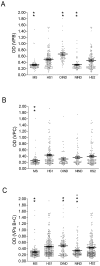Significant low prevalence of antibodies reacting with simian virus 40 mimotopes in serum samples from patients affected by inflammatory neurologic diseases, including multiple sclerosis
- PMID: 25365364
- PMCID: PMC4218715
- DOI: 10.1371/journal.pone.0110923
Significant low prevalence of antibodies reacting with simian virus 40 mimotopes in serum samples from patients affected by inflammatory neurologic diseases, including multiple sclerosis
Abstract
Many investigations were carried out on the association between viruses and multiple sclerosis (MS). Indeed, early studies reported the detections of neurotropic virus footprints in the CNS of patients with MS. In this study, sera from patients affected by MS, other inflammatory (OIND) and non-inflammatory neurologic diseases (NIND) were analyzed for antibodies against the polyomavirus, Simian Virus 40 (SV40). An indirect enzyme-linked immunosorbent assay (ELISA), with two synthetic peptides, which mimic SV40 antigens, was employed to detect specific antibodies in sera from patients affected by MS, OIND, NIND and healthy subjects (HS). Immunologic data indicate that in sera from MS patients antibodies against SV40 mimotopes are detectable with a low prevalence, 6%, whereas in HS of the same mean age, 40 yrs, the prevalence was 22%. The difference is statistically significant (P = 0.001). Significant is also the difference between MS vs. NIND patients (6% vs. 17%; P = 0.0254), whereas no significant difference was detected between MS vs OIND (6% vs 10%; P>0.05). The prevalence of SV40 antibodies in MS patients is 70% lower than that revealed in HS.
Conflict of interest statement
Figures

References
-
- Granieri E (1997) The epidemiology study of exogenous factors in the etiology of multiple sclerosis. Introduction. Neurology 49 S2:S4.
-
- Compston A, Coles A (2002) Multiple sclerosis. Lancet 359: 1221–1231. - PubMed
-
- Giovannoni G, Cutter GR, Lunemann J, Martin R, Munz C, et al. (2006) Infectious causes of multiple sclerosis. Lancet neurology 5: 887–894. - PubMed
-
- Giovannoni G, Ebers G (2007) Multiple sclerosis: the environment and causation. Current opinion in neurology 20: 261–268. - PubMed
-
- Myhr KM, Riise T, Barrett-Connor E, Myrmel H, Vedeler C, et al. (1998) Altered antibody pattern to Epstein-Barr virus but not to other herpesviruses in multiple sclerosis: a population based case-control study from western Norway. Journal of neurology, neurosurgery, and psychiatry 64: 539–542. - PMC - PubMed
Publication types
MeSH terms
Substances
LinkOut - more resources
Full Text Sources
Other Literature Sources
Medical

